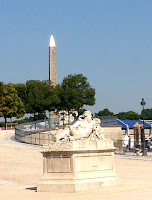It was one of those wonderful days. Woke up to a clear blue sky, no wind on the balcony and up and about when the rest of Paris seemed to be sleeping. The sun was rising and sipping my tea, I watched it as the rays came over the balcony and into my living room. A day when there were no real projects, nothing important to do - so what would I do? First plan was to go over to the Orangerie and discover the Macchiaili - or the Italian impressionists. It wasn’t a must as Gianni and I had seen quite a lot where were in Florence. More important perhaps was the walk across the Tuileries gardens which were more or less empty at that hour of the morning.
 |
| Concorde from the Tuileries - blue sky |
 |
| Dubuffet could be a horse.... |
A sign on the door told me that the museum was having computer problems (sic) and wouldn’t be open until late morning. What now? Ah, another exhibition which was not a must but even so could be interesting was Tamara de Lempicka at the Pinocotheque. So from the Tuileries, I walked over to the Madeleine - no queues, no-one. Tourists may not be early risers....
 |
| Lizette 1926 |
My introduction to Lempicka was when I was still in activity and an ex student of mine launched the first Lempicka perfume. I knew nothing about the artist. The next time I came across her was in a small exhibition at the Pinocotheque some years ago now, when I discovered this. "Kizette" (her daughter Lisette) in pink" -1926. A cubist style I thought which made the painting look very modern in my eyes. Everything about Lisette seemed like porcelaine. A breakable doll and yet this young lady looked very mature.
So who was Tamara (de) Lempicka? (1898-1980). She was born in Varsovie into a very rich Polish family who gave her a multinational education from the start. French, Polish a grandmother who took her to discover Italy in 1911 and that is where she became passionate about art.She moves in with her aunt to Saint Petersbourg (her new step father is not to her liking) and there she meets her first husband - a young rich lawyer .The Bolcheviks and the revolution of 1917 means Tadeuz her husband and she escape moving to Paris. There Tamara takes the name of Tamara de Lempicka, has art lessons and her modern and slightly erotic style develops. Slowly but surely she becomes known, has many orders, become the mistress of Baron Kuffner and has her first trip to the States....there is a second and a third husband. Periods when she is very depressed, others when she is successful again.....her ups and downs are quite notorious. If I am telling you all this is simply because Tamara was a declared bi-sexual and her homosexuality gave way to some of the most exotic nudes of the early 20th century. There are more of her paintings and nudes (1925-33) which are on the front pages of books etc. than any other artist of her period. In these last years, Christies and Sothebys sell her work at $$$$$. She’s modern, full of confidence (outside of her depressed periods) and very independent. This was an Art Deco period where women flaunted their sexual desires.
 |
| Double "47' 1924 |
 |
| Irene and her sister |
 |
| La Belle Rafaëla 1927- |
 |
| Portrait-of-Arlette-Boucard,-1928 |
 |
| In her studio |
Misia or the Queen of Paris, was another such woman (see
Misia was also Polish and posed for some of the most famous painters of that period. She too married into money and accepted her husband when he took a mistress. «Menage à trois» I wonder if the two women met? I have seen no reference to such a meeting.
Tamara’s style is inimitable. Porcelaine, diaphanous, eyes which are rather bulbous at times, full lips and hands which are always beautiful - manicured even when she painted a peasant. She also worked in advertising and was known for her front pages in posh magazines etc.
 |
| Saint Moritz and also a magazine cover 1929 |
 |
| Beggar with mandoline- Not quite her style |
 |
| Two girls with ribbons 1925 |
You or may not like her work, but one thing is sure, you don’t forget her style and neither do you recall it when she deviates..














Commentaires